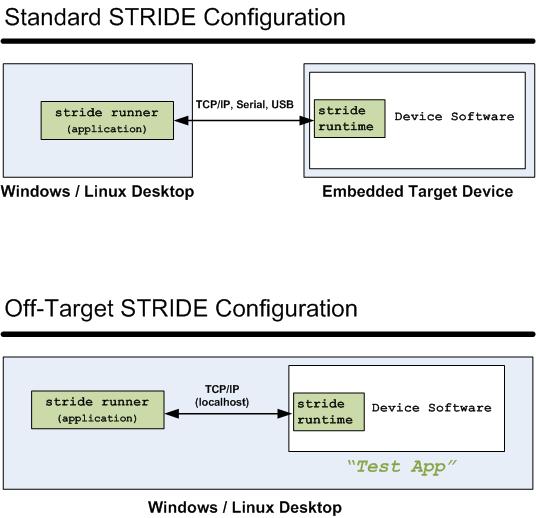Off-Target Environment: Difference between revisions
| Line 1: | Line 1: | ||
== Overview == | == Overview == | ||
[[image:STRIDE_Desktop.jpg|right|The Off-Target configuration puts both host and target code on the desktop]] | [[image:STRIDE_Desktop.jpg|right|The Off-Target configuration puts both host and target code on the desktop]] | ||
Two of the largest barriers to embedded developer productivity are long build/test cycles and scarce target hardware. Fortunately, STRIDE's cross-platform capabilities make it possible to run STRIDE in a host-only ''Off-Target Configuration'' that emulates your target system | Two of the largest barriers to embedded developer productivity are long build/test cycles and scarce target hardware. Fortunately, STRIDE's cross-platform capabilities make it possible to run STRIDE in a '''host-only''' ''Off-Target Configuration'' that emulates your target system. All of the supplied [[Samples | samples]] run identically under either the Off-Target environment or your actual target. In addition, any test code you write will also run in either environment. This enables the user to create their own '''sandbox''' for training and Off-Target unit testing. | ||
The Off- | The Off-Target Environment utilizes the [[Desktop_Installation#SDK|Framework's "SDK"]] that can be built and executed on the host system. The [[STRIDE Runner]] application executes on the same system and communicates with the "target" process over a TCP/IP connection. This set up frees you from external hardware dependencies and provides for a rapid "edit/build/test" cycle. | ||
== Evaluation Steps == | == Evaluation Steps == | ||
Revision as of 15:21, 23 August 2010
Overview
Two of the largest barriers to embedded developer productivity are long build/test cycles and scarce target hardware. Fortunately, STRIDE's cross-platform capabilities make it possible to run STRIDE in a host-only Off-Target Configuration that emulates your target system. All of the supplied samples run identically under either the Off-Target environment or your actual target. In addition, any test code you write will also run in either environment. This enables the user to create their own sandbox for training and Off-Target unit testing.
The Off-Target Environment utilizes the Framework's "SDK" that can be built and executed on the host system. The STRIDE Runner application executes on the same system and communicates with the "target" process over a TCP/IP connection. This set up frees you from external hardware dependencies and provides for a rapid "edit/build/test" cycle.
Evaluation Steps
To simplify the evaluation, we recommend using a single Windows or Linux (x86) computer for both the target and host systems. Host and target code will run in separate processes and communicate via TCP/IP, thus simulating an embedded target with host computer configuration. All code and techniques used in the Off-Target Environment are directly transferable to a production environment.
The recommended evaluation steps are as follows:
- Review the STRIDE Overview
- Install required desktop Framework package
- Configure STRIDE Test Space for publishing results
- Build the basic TestApp with built-in S2 diagnostic tests
- Build and test the TestApp with Unit Tests examples.
- Build and test the TestApp with the Behavior (Expectations) Tests examples, publishing results to Test Space
- Explore other Samples
